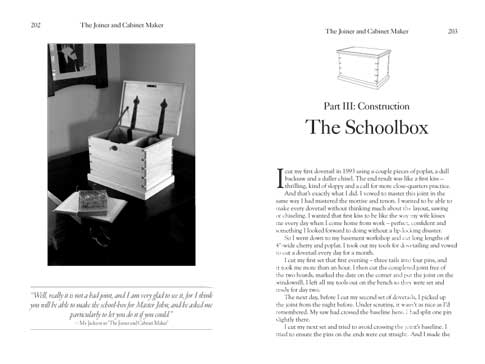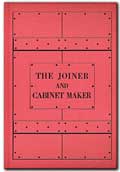
Now you can pre-order a copy of “The Joiner and Cabinet Maker” signed by me. By pre-ordering the book today for $29 (plus $5 shipping in the United States), you’ll get one of the first copies of this landmark new woodworking book. But, in true Lost Art Press fashion, you will not be charged (or even asked for a credit card number) until the book is available and ready to ship.
In other words, you cannot lose.
Click here to visit our pre-order form. Click below to download an excerpt of the original text (it’s different than what is posted at Tools for Working Wood).
Preview_Joiner_&_Cabinet_Maker_LAP.pdf (998.55 KB)
Or read on….
Right now we’re making the final arrangements with the printer, but the book is complete and we’re just waiting for some time on a printing press. I’m trying to get back to my normal life, and I’m sure that Joel Moskowitz at Tools for Working Wood is doing the same thing.
If we were dumb enough to conduct a true tally of hours Joel and I spent on this book, plus the money for the wood, hardware, finish, a few critical woodworking tools and scanning services, then our wives would surely ask us to take up a more-profitable sideline, such as selling our plasma.
But believe me, we’re not complaining. This book was tremendous fun for us to piece together, from the very early stages of researching the original text of “The Joiner and Cabinet Maker” to the eight full months of poring over old texts, building and writing that followed.  The real reason we published this little book is because we were both so excited when we first read the text of “The Joiner and Cabinet Maker” that we wanted to share it with other woodworkers who were as enthusiastic about history and hand-tool woodworking as we are. You are the people who sustain us in our day jobs. You buy tools from Joel at Tools for Working Wood and Gramercy Tools. You buy magazines and books from me at Popular Woodworking, Woodworking Magazine and Lost Art Press.
The real reason we published this little book is because we were both so excited when we first read the text of “The Joiner and Cabinet Maker” that we wanted to share it with other woodworkers who were as enthusiastic about history and hand-tool woodworking as we are. You are the people who sustain us in our day jobs. You buy tools from Joel at Tools for Working Wood and Gramercy Tools. You buy magazines and books from me at Popular Woodworking, Woodworking Magazine and Lost Art Press.
And after many years of working with our customers, we were certain that you would find the contents of “The Joiner and Cabinet Maker” as thrilling as a beach novel.
Within this small and obscure 1839 book is the direct evidence for how many day-to-day tasks were executed in an 18th- and early 19th-century English workshop. Told through the tale of a fictional lad named Thomas, it is a remarkable account of many aspects of the apprentice system and how basic skills were conveyed. Here is a sample:
• Dovetailing: See exactly how the joints were laid out, cut and assembled, including 19th-century advice on fitting the joint that should prove helpful to 21st-century woodworkers.
• The basic toolkit: By modern standard, the projects in “The Joiner and Cabinet Maker” were built with surprisingly few tools. Discover what the core kit is and how to stretch your tools to accomplish more.
• Case construction and vernacular furniture forms. The three projects presented in “The Joiner and Cabinet Maker” aren’t high-style urban pieces. Instead, they are simpler forms with less ornamentation that look surprisingly contemporary. However, the three projects in this book form the backbone of cutting traditional case joinery by hand and are the foundation for every form of furniture, from Shaker to Rococo.
• Tool-buying decisions. Find out how 19th-century craftsmen purchased tools. Did they scrape by and improvise, did they purchase the most expensive tools available or did they perhaps choose a third path?
Is “The Joiner and Cabinet Maker” the Rosetta Stone of early woodworking? Hardly. There still are many unanswered questions about how some basic and many advanced operations were performed. The book doesn’t even mention moulding planes or carving, for example.
But this book is an excellent place to begin – both for hand-tool woodworkers who want to commence their journey and for experienced woodworkers who want a sense of how their ancestors were trained to work so productively. Our edition of this book begins with a chapter written by Joel that provides a snapshot of England and the state of woodworking in the 19th century. That’s followed by the original text, which we have reset in a larger font but left otherwise unaltered. Joel has provided footnotes throughout the original text that will help explain the significance of what you are reading. Next are chapters that I wrote that detail how to build the three projects. He also compares the techniques in the book with hand-tool techniques that have either developed since then or simply aren’t discussed in “The Joiner and Cabinet Maker.”
The last section of the book is quite useful. There you will find some conclusions, a chapter on how the different editions of the original “The Joiner and Cabinet Maker” were printed and bound, plus a list of other useful books on history and hand-tool woodworking.
We encourage you to read this entire book and attempt to build the three projects using hand tools. That is a tall order, we know. However, building the Packing Box, the Schoolbox and the Chest of Drawers will unlock the basic skills needed for all hand-tool woodworking, and it will offer insights into how traditional, high-quality casework was really built.
Click here to pre-order the book.
Click below to download the Lost Art Press excerpt.
Preview_Joiner_&_Cabinet_Maker_LAP.pdf (998.55 KB)
— Christopher Schwarz